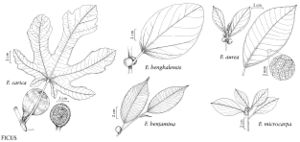Difference between revisions of "Ficus microcarpa"
Suppl. Pl., 442. 1782.
FNA>Volume Importer |
FNA>Volume Importer |
||
| Line 27: | Line 27: | ||
}}<!-- | }}<!-- | ||
| − | --><span class="statement" id="st- | + | --><span class="statement" id="st-undefined" data-properties=""><b>Trees,</b> evergreen, to 30 m. <b>Roots</b> aerial, abundant, sometimes developing pillar-roots. <b>Bark</b> gray. <b>Branchlets</b> brown, glabrous. <b>Leaves</b>: stipules 0.7-0.9 cm; petiole 0.5-1 cm. <b>Leaf</b> blade elliptic, obovate to ovate, 3-11 × 1.5-6 cm, thinly leathery, base obtuse to cuneate, margins entire, apex nearly acute to acuminate; surfaces abaxially and adaxially glabrous; basal veins 1(-2) pairs; lateral veins 5-9 pairs, uniformly spaced. <b>Syconia</b> paired, sessile, purple or black, obovoid, pyriform, or nearly globose, 9-11 × 5-6 mm; subtending bracts ovate-lanceolate, 1.5-3.5 mm, apex obtuse to subacute; ostiole closed by 3 flat, apical bracts 2-2.5 mm wide, umbonate.</span><!-- |
-->{{Treatment/Body | -->{{Treatment/Body | ||
| Line 33: | Line 33: | ||
|habitat=Disturbed sites | |habitat=Disturbed sites | ||
|elevation=0-20 m | |elevation=0-20 m | ||
| − | |distribution=Fla.;West Indies;native to Eastern Hemisphere | + | |distribution=Fla.;West Indies;native to Eastern Hemisphere. |
|discussion=<p>Ficus microcarpa is commonly cultivated in Florida. At press time, word had been received (Michael O'Brien, pers. comm.) that F. microcarpa was recently found in the Los Angeles area, where the pollinating wasp apparently has been present since 1992. Voucher specimens are not yet available.</p> | |discussion=<p>Ficus microcarpa is commonly cultivated in Florida. At press time, word had been received (Michael O'Brien, pers. comm.) that F. microcarpa was recently found in the Los Angeles area, where the pollinating wasp apparently has been present since 1992. Voucher specimens are not yet available.</p> | ||
|tables= | |tables= | ||
| Line 53: | Line 53: | ||
|habitat=Disturbed sites | |habitat=Disturbed sites | ||
|elevation=0-20 m | |elevation=0-20 m | ||
| − | |distribution=Fla.;West Indies;native to Eastern Hemisphere | + | |distribution=Fla.;West Indies;native to Eastern Hemisphere. |
|introduced=true | |introduced=true | ||
|reference=None | |reference=None | ||
| Line 59: | Line 59: | ||
|publication year=1782 | |publication year=1782 | ||
|special status=Selected by author to be illustrated;Introduced | |special status=Selected by author to be illustrated;Introduced | ||
| − | |source xml=https://jpend@bitbucket.org/aafc-mbb/fna- | + | |source xml=https://jpend@bitbucket.org/aafc-mbb/fna-data-curation.git/src/9216fc802291cd3df363fd52122300479582ede7/coarse_grained_fna_xml/V3/V3_291.xml |
|genus=Ficus | |genus=Ficus | ||
|species=Ficus microcarpa | |species=Ficus microcarpa | ||
| − | |||
| − | |||
| − | |||
| − | |||
| − | |||
| − | |||
| − | |||
| − | |||
| − | |||
| − | |||
| − | |||
| − | |||
| − | |||
| − | |||
| − | |||
| − | |||
| − | |||
| − | |||
| − | |||
| − | |||
| − | |||
| − | |||
| − | |||
| − | |||
| − | |||
| − | |||
| − | |||
| − | |||
| − | |||
| − | |||
| − | |||
| − | |||
| − | |||
| − | |||
| − | |||
}}<!-- | }}<!-- | ||
-->[[Category:Treatment]][[Category:Ficus]] | -->[[Category:Treatment]][[Category:Ficus]] | ||
Revision as of 14:37, 27 July 2019
Trees, evergreen, to 30 m. Roots aerial, abundant, sometimes developing pillar-roots. Bark gray. Branchlets brown, glabrous. Leaves: stipules 0.7-0.9 cm; petiole 0.5-1 cm. Leaf blade elliptic, obovate to ovate, 3-11 × 1.5-6 cm, thinly leathery, base obtuse to cuneate, margins entire, apex nearly acute to acuminate; surfaces abaxially and adaxially glabrous; basal veins 1(-2) pairs; lateral veins 5-9 pairs, uniformly spaced. Syconia paired, sessile, purple or black, obovoid, pyriform, or nearly globose, 9-11 × 5-6 mm; subtending bracts ovate-lanceolate, 1.5-3.5 mm, apex obtuse to subacute; ostiole closed by 3 flat, apical bracts 2-2.5 mm wide, umbonate.
Phenology: Flowering all year.
Habitat: Disturbed sites
Elevation: 0-20 m
Distribution

Fla., West Indies, native to Eastern Hemisphere.
Discussion
Ficus microcarpa is commonly cultivated in Florida. At press time, word had been received (Michael O'Brien, pers. comm.) that F. microcarpa was recently found in the Los Angeles area, where the pollinating wasp apparently has been present since 1992. Voucher specimens are not yet available.
Selected References
None.
